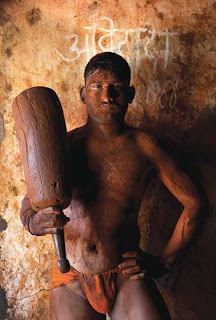By Palani Mohan
Asia Literary Review
LORD HANUMAN, the monkey god of the Ramayana, is revered in Kolhapur. It was Hanuman who helped rescue Sita, Rama’s wife, from the demon Ravana. And it was Hanuman who flew to the Himalayas and carried back a mountain with medicinal herbs to save Rama’s brother, Laksmana. He symbolises immense strength and fearlessness and it is to him that India’s wrestlers pray for victory.
Since India’s wrestlers took home medals from the 2008 Olympic Games in Beijing, the spotlight has been turned on kushti, a 3,000-year-old martial art still practised in small pockets of India, Pakistan and Iran; a relic, if you like, of shared Aryan traditions and with a rich moral, ethical, philosophical and mystical heritage. Its ancestry is that of the warrior and it finds mention in the historical record of Parthia, which prevailed as an empire from 132BCE–226CE, a thorn in the side of Rome until vanquished in the time of Emperor Marcus Aurelius. But by then kushti had spread throughout the Roman empire; it is arguably the antecedent of the Graeco-Roman style.
Kushti is under threat as India’s sporting authorities, buoyed by Olympic success, seek to force its best practitioners to abandon the mud pits for the wrestling mat and train in the more recognised styles of wrestling.
READ MORE HERE



No comments:
Post a Comment